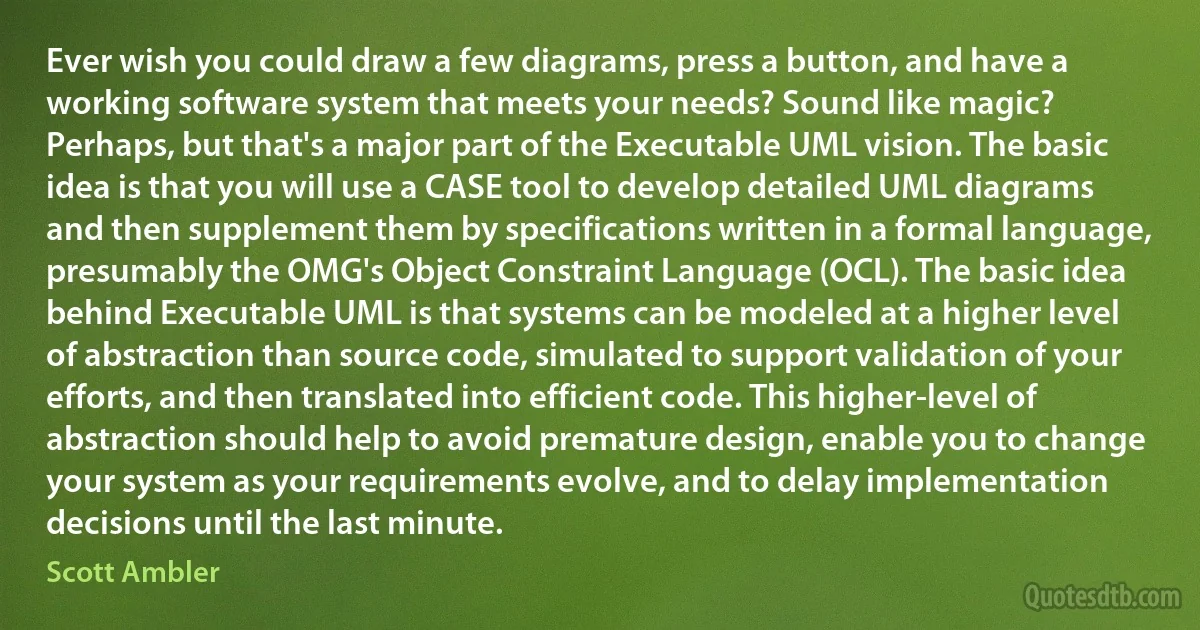
Ever wish you could draw a few diagrams, press a button, and have a working software system that meets your needs? Sound like magic? Perhaps, but that's a major part of the Executable UML vision. The basic idea is that you will use a CASE tool to develop detailed UML diagrams and then supplement them by specifications written in a formal language, presumably the OMG's Object Constraint Language (OCL). The basic idea behind Executable UML is that systems can be modeled at a higher level of abstraction than source code, simulated to support validation of your efforts, and then translated into efficient code. This higher-level of abstraction should help to avoid premature design, enable you to change your system as your requirements evolve, and to delay implementation decisions until the last minute.
Scott AmblerRelated topics
abstraction basic behind button case change code delay draw few formal help idea language last minute needs perhaps should sound source supplement support use validation vision wish working write implementation software higher meets specificationsRelated quotes
No, the Great Man does not boast himself sincere, far from that; perhaps does not ask himself if he is so: I would say rather, his sincerity does not depend on himself; he cannot help being sincere! The great Fact of Existence is great to him. Fly as he will, he cannot get out of the awful presence of this Reality. His mind is so made; he is great by that, first of all. Fearful and wonderful, real as Life, real as Death, is this Universe to him. Though all men should forget its truth, and walk in a vain show, he cannot. At all moments the Flame-image glares in upon him; undeniable, there, there!-I wish you to take this as my primary definition of a Great Man. A little man may have this, it is competent to all men that God has made: but a Great Man cannot be without it.

Thomas Carlyle
Systems with unknown behavioral properties require the implementation of iterations which are intrinsic to the design process but which are normally hidden from view. Certainly when a solution to a well-understood problem is synthesized, weak designs are mentally rejected by a competent designer in a matter of moments. On larger or more complicated efforts, alternative designs must be explicitly and iteratively implemented. The designers perhaps out of vanity, often are at pains to hide the many versions which were abandoned and if absolute failure occurs, of course one hears nothing. Thus the topic of design iteration is rarely discussed. Perhaps we should not be surprised to see this phenomenon with software, for it is a rare author indeed who publicizes the amount of editing or the number of drafts he took to produce a manuscript.

Fernando J. Corbató
As we walked homeward across the fields, the sun dropped and lay like a great golden globe in the low west. While it hung there, the moon rose in the east, as big as a cart-wheel, pale silver and streaked with rose colour, thin as a bubble or a ghost-moon. For five, perhaps ten minutes, the two luminaries confronted each other across the level land, resting on opposite edges of the world.
In that singular light every little tree and shock of wheat, every sunflower stalk and clump of snow-on-the-mountain, drew itself up high and pointed; the very clods and furrows in the fields seemed to stand up sharply. I felt the old pull of the earth, the solemn magic that comes out of those fields at nightfall. I wished I could be a little boy again, and that my way could end there.

Willa Cather
I'm against these aggressive tax avoidance schemes but I'm not just against them, this Government has taken a huge amount of steps to legislate and toughen the laws and go after aggressive tax avoidance schemes for the very simple reason that if people go after these schemes and aggressively avoid tax they're making it the case that everyone else has to pay higher taxes as a result so I think we should be very clear, tax evasion is illegal and for that you can be prosecuted, you can go to prison for tax evasion. Tax avoidance is in these cases, very aggressive tax avoidance schemes, they are wrong and we should really persuade not to do them and that's why we have these court cases where the court looks at whether a scheme is really about avoiding tax rather than anything else and the court was very clear in this case.

David Cameron
It is my burning desire to help Christians get back to a simple faith in God's Word. Satan's method has always been to instill [sic] doubt in God's Word. The first sentence that came from Satan that is recorded for us in the Bible is: "Yea, hath God said?” He started by questioning God's Word in the garden of Eden. It worked there so he has used it ever since. In the twentieth century the major attack Satan has launched has been against the first eleven chapters of Genesis. He knows that the entire Bible stands or falls on the validity of these chapters. I believe that the Bible is the infallible, inerrant, inspired, perfect Word of God. I believe that the Bible needs to be read and believed as it stands. Christians are often guilty of neglecting or twisting the Bible to fit their lifestyle or their preconceived ideas.

Kent Hovind
